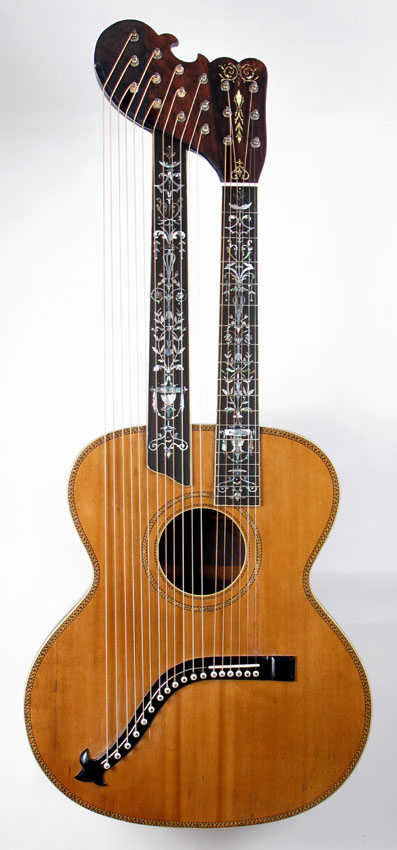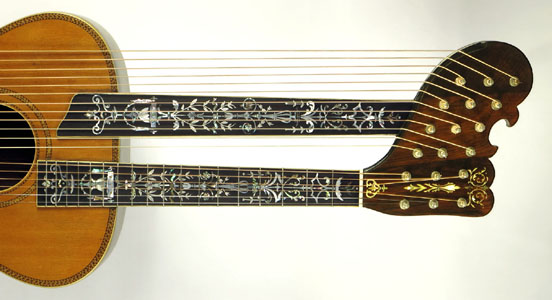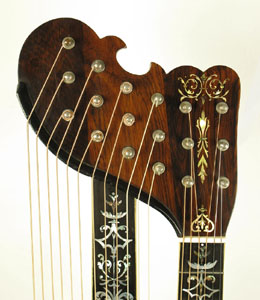![]()
Featured Harp Guitar of the Month
Weymann Harp Guitar
with Double "Tree of Life" inlay
by Gregg Miner, September, 2013
 |
|
| Luckily, the precise outline of the bridge remained. Not only
that, but right at this time, I received photos of this nearly identical
(but plain) harp guitar (at left) from owner Jim McKenna. He, too,
was wondering what his unlabeled instrument might be. We noted
that the headstock was identical, as was the body and overall
dimensions. Only the bass "neck" termination
(coincidentally reminiscent of Bohmann) and bridge shape were slightly
different. Jim kindly sent additional photos of the bridge from
all angles, to help Kerry craft a reproduction for mine.
By the way, you've now seen all three surviving Weymann harp guitars (one labeled, two "attributed to"). After a couple years (of nagging; Kerry's always overloaded), the initial repairs were done and I was able to see the (almost-finished) restoration. Kerry had repaired the multiple cracks, done the bridge, neck resets, finish touch up, etc., and while apart, also beefed up the neck block, soundhole reinforcement, ladder bracing and bridge plate - as we wanted to make sure this would play while staying in one piece. Let's take a quick look (sorry, the solid Brazilian rosewood back and sides still did not photograph well enough): |
| Before diving into string options and playing it, however, I wanted to
improve the appearance of the neck inlay, which was of inconsistent
quality to begin with, and missing way too many portions for my
tastes. On it went to inlay expert Jimmi
Wingert for major touch-up. However, this poor woman is so in
demand by high end luthiers (including her mother), that after a
year in the queue, Kathy
Wingert tackled it for me.
The one problem with expert guitar builders working on some of these
vintage instruments is convincing them to "do a crappy
job." It's anathema
to them. But that's what this one required. We had long
talks about how far to take the inlay repair. Missing pieces were
not the real issue, nor consistency (the job required a certain
sloppiness to match the original).
She explained that the symmetry would need to be the key goal, as
that would be the giveaway. I'm sure it drove Kathy crazy, but in
the end, it looks nicely blended in and "historical." |
 |
 |
Next problem...
The fingerboard inlay now looked about as bright as it may have when new (the fingerboards being of course unfinished)... ...but the beautiful headstock inlay – all but invisible under the thick dark, colored, aged shellac – was now bothering me. The lovely 3-piece Brazilian rosewood veneer also had a lot of finish issues, wear and discoloration. So I decided to take it to French polish whiz, Richard Reynoso, a classical guitar builder, and occasional restorer for me (who had conveniently moved to much closer Hollywood since I had last seen him). Again, it pained him to have to do a less-than-perfect job. But we were forced with the reality of the very obviously worn and repaired and blemished spruce top as our "model." Of course, his job was was still way too gorgeous, and we had to hit it with pumice to dull and scratch it enough for my liking. |
| Let's talk a bit more about the H. A. Weymann Company,
active from 1864 into the 1940's, according to Mugwumps
Online...
...and, that's about it. Seriously, very little information has been written on this Philadelphia manufacturer. The Music Trade Review Archives are probably worth searching more in-depth (the hits consist largely of a repeating ad). In the March 20, 1920 issue, there's a nice profile that names those involved at the end.
A 1913 issue mentions yet another Weymann, William, "who is in charge of the factory." Their claim to fame are their banjos, mainly the highly decorated tenors of the '20s and '30s (all rare, with a nice archive here). Of their even rarer guitars, Frank Ford once wrote "Weymann was one of the great banjo producers in Philadelphia...although they did venture into guitars, mandolins and ukes. All Weymann instruments were characterized by exceptionally fine woodworking, fit and finish." Three Weymann catalogs at Vintage Axe (1928, 1931 and 1937) show a few standard 6 string guitars, an F-hole “Hawiian” with extension nut, the "Jimmy Rodgers" model, and finally archtops, along with their more common mandolins called "mandolutes." No harp guitars, although that's expected at this late date. So when were the harp guitars made? The general workmanship, combined with the friction tuners and inclusion of a full twelve sub-basses points to early (1900's), yet if the inlay matches later Weymann (or Stewart or Ludwig) banjos, that points to the 'twenties. I found just a couple clues in The Music Trade Review: From the Oct 11, 1913 issue,
And from Dec 20, 1913:
Sadly, this doesn't help us at all, as the two known "models" have 13 strings and 18 strings (the two MTR articles are almost certainly referring to a 6-sub-bass harp guitar). Neither does the 1913 text suggest that this was the first, or just another new harp (contra-bass) guitar. |
| Note also the slightly different bindings.
The 7-bass Weymann also has a wild, pearl decorated bridge (again,
originality unknown).
So there you have it. An unbelievably ornate harp guitar "attributed to" H. A. Weymann & Son, nicely restored and resurrected. Whether I find my "smoking gun" provenance or not, I'm pretty convinced...and just honored to be its current custodian! |
|
|
Harp Guitar of the Month: Archives |
| Collectors,
Authors, Scholars: Want to create a page about a certain harp guitar
maker or instrument? Contact
me!
If you enjoyed this article, or found it useful for research, please consider supporting Harpguitars.net so that this information will be available for others like you and to future generations. Thanks!
|
|
|
|
All Site Contents Copyright © Gregg Miner, 2004,2005,2006,2007,2008,2009,2010,2011,2012,2013. All Rights Reserved. Copyright and Fair Use of material and use of images: See Copyright and Fair Use policy. |